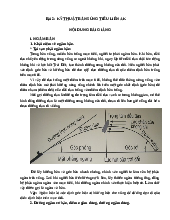













Preview text:
CASE NAME:
Chevrolet: A Century of Product Innovation. Group Name: Phoenix 1. Đoàn Thị B o
ả Vy.................. ................. ......(GL)
2. Đinh Quang Vinh ............. ................. .........(GM) 3. Nguy n ễ Th ịNg c
ọ Trang............................(GM)
4. Đoàn Thị Thùy Trang.............. ................. (GM)
5. Phùng Bá Phát ......... ....................... ............(GM) Semester: 2331 (2023-2024) Subject: MARKETING STRATEGY Instructor: Tr n ươ g Quang C m ẩ CONTENTS
PART I: MARKETING STRATEGY ANALYSIS........................................................................................... 1 1.
Current Marketing strategy:............................................................................................................. 1
a) Segmentation bases:......................................................................................................................... 1
b) Targeting................................................................................................................................................ 1
c) Differentiation: Describe the differentiation base of the firm vs. their
competitors:................................................................................................................................................... 1
d) Positioning: Describe the positioning strategy of the firm:........................................2 2.
Current Marketing mix........................................................................................................................ 2
a) Products.................................................................................................................................................. 2
b) Price.......................................................................................................................................................... 3 c)
Place.......................................................................................................................................................... 3
d) Promotion.............................................................................................................................................. 3
PART II: ANSWERS............................................................................................................................................... 4
Question 1: Evaluate the diversity of vehicle types and sizes that are sold under the
Chevrolet brand name. What strengths and weaknesses are evident in Chevy’s
product mix?...................................................................................................................................... 4
a) Answer by students’ words............................................................................................... 4
b) Verbatim citation from the case...................................................................................... 6 c)
Citation from the textbook................................................................................................ 7
Question 2: How has Chevrolet strategically managed its brand and reputation
over the last 100 years? What opportunities and threats will affect Chevy’s
branding and reputation in the future? ................................................................................... 7
d) Answer by students’ words.............................................................................................. 7
e) Verbatim citation from the case...................................................................................... 8 f)
Citation from the textbook................................................................................................ 9
Question 3: What specific marketing strategies would you recommend that might
help Chevrolet last another 100 years? How important is Chevy’s legacy of
innovation to the brand’s future? 9
g) Answer by students’ words........................................................................................................... 9
h) Verbatim citation from the case.............................................................................................. 11 i)
Citation from the textbook......................................................................................................... 11
PART I: MARKETING STRATEGY ANALYSIS
1. Current Marketing strategy: a) Segmentation bases:
Segmentation bases for B2C
Chevrolet segments the market based on demographic characteristics such as age
(under 20 years old, 20 - 55 years old, over 55 years old). In addition, the company
also focuses on geographical factors such as country (254 countries), psychological
factors such as social class (upper class, middle class, lower class). For behavioral
segmentation, Chevrolet considers aspects such as benefits sought (Quality, service,
economy), usage rate (light, medium, and heavy product users) b) Targeting
The target market of the firm consists of people with young and middle-aged
(about 20 to 55 years old) located in United States, India, China, Mexico, Egypt ,
Korea and South America. Chevrolet focuses on middle-class customers, who care
about quality and price. Most of Chevrolet's customers are Heavy Users, they need to use the car every day.
c) Differentiation: Describe the differentiation base of the firm vs. their competitors:
The competitors of Chevrolet:
- Competitor 1: Ford Motor Company is Chevrolet's top competitor and a brand
associated with American culture, part of America's heritage.
- Competitor 2: Hyundai Sonata is one of the competitive brands in the automobile industry.
- Competitor 3: Toyota is Chevrolet's rival in terms of advanced technology
equipment when Toyota entered the US market. 1
Select the differentiation base of the firm Differentia tion bases Product Services Channels People Image attributes Criteria 1 Important 8 7 7 4 10 2 Distinctive 9 8 9 5 8 3 Superior 8 9 8 4 10 4 Communicable 8 10 9 3 9 5 Preemptive 9 8 7 5 8 6 Affordable 9 10 8 4 9 7 Profitable 10 9 8 4 10 Total points 61 61 56 29 64
=> Compared to competitors, Chovrolet differs mainly in image (brand).
d) Positioning: Describe the positioning strategy of the firm:
For people between 20 and 55 years old, located in the United States, India, China,
Mexico, Ai Egypt, Korea and South America, South Africa, who want to buy unique
car models with the most modern and states of the art features. Chevrolet is a car
brand providing novel products and new technology ahead of its time.
2. Current Marketing mix a) Products Cars SUVs/Crossovers Vans Electric Vehicles Trucks Sonic Equinox Colorado Volt Cruze Traverse City Express Spark EV Malibu Tahoe Silverado Corvette Suburban Express Camaro Trax Impala Spark 2 b) Price Product Covertte Camaro Cruze Volt SUV/Crossover Silverado Impala Price 50.000$ - 500$ to 17.000$ 41.000$ over 2.500$ 100.000$ c) Place d) Promotion Advertising:
Brand and product strategy:
- When Durant first established Chevrolet, his goal was to produce an affordable car
to compete with Ford. One of their initial slogans was "Quality and Low Cost".
- Chevrolet has successfully used the advertising slogan "Like a Rock" in all of their
truck advertising campaigns, especially for the Silverado series. This strategy has
helped the brand create an impression of reliability, strength, and durability for their products. 3
- Chevrolet has used the theme of patriotism and slogans like "America's Best-
Selling Car" and "Baseball, Hot Dogs, Apple Pie, and Chevrolet" to demonstrate their
connection to the United States.
- Chevrolet has maintained a theme related to the United States through slogans like
"An American Revolution" in 1994, "Chevy Runs Deep," and more recently, "Find New Roads."
- GM renamed the Daewoo brand to Chevrolet with the hope of increasing
awareness and competing better in the South Korean market, even though Daewoo's
car sales had been increasing in recent years. Public relations (PR):
Competitive strategy:
In the marketing strategy for the Cruze series, Chevrolet uses a competitive strategy
by using advertisements voiced by Tim Allen. They encourage viewers to "get to
know more" about the Cruze while also criticizing the Toyota Corolla in the "Dear
Corolla" advertisements for not offering the newest technology. This emphasizes the
superiority of the Cruze in the competitive industry.
Sponsorship and event strategy:
In 1935, Chevrolet began sponsoring the Soap Box Derby race and continued this
support in the following decade. Chevrolet cars was driven by famous racers like Jeff
Gordon and Jimmie Johnson, they frequently appeared on the racetracks. PART II: ANSWERS
Question 1: Evaluate the diversity of vehicle types and sizes that are sold
under the Chevrolet brand name. What strengths and weaknesses are evident
in Chevy’s product mix?
a) Answer by students’ words
Evaluate the diversity of vehicle types and sizes: 4
- Chevrolet offers a range of vehicles, from small to large and from traditional cars to
electric ones, reflect its ability to meet diverse customer needs.
- This diversity helps Chevrolet expand its presence across various market
segments, catering to families and individuals with specific needs.
- The ability to provide a variety of vehicles makes the brand flexible in adapting to
market fluctuations and consumer preferences.
- The product diversity establishes a strategic advantage, enabling Chevrolet to
maintain a strong position in the highly competitive automotive industry.
Evaluate strengths and weaknesses: Strengths: -
Chevrolet get benefits from strong customer loyalty, especially in the light
truck segment, creating an advantage right from product launch. -
The strategy of introducing a new model every year helps Chevrolet surpass
competitors, maintaining brand integrity and attracting customers. -
Models like the Corvette are particularly famous and enduring, contributing
positively to Chevrolet's image. Weaknesses: -
Safety incidents, as in the case of Corvair, and product failures like Vega have
created negative impacts, posing a challenge in managing the brand's reputation. -
The unsuccessful launch of the Vega due to poor quality and product recalls
generated negative publicity, affecting the brand's image.
-> Chevrolet possesses strong customer loyalty and a flexible marketing strategy,
but faces challenges from safety incidents and product failures. Managing the
brand's reputation carefully is crucial for Chevrolet to maintain and enhance its
position in the competitive automotive market.
b) Verbatim citation from the case 5
The diversity of vehicle types and sizes: Cars SUVs/Crossovers Vans Electric Vehicles “T Trucks he Sonic Equinox Colorado Volt Cruze Traverse City Express Spark EV Malibu Tahoe Silverado Corvette Suburban Express Camaro Trax Impala Spark
company has developed large trucks; delivery vans; full-size, mid-size, compact, and
sub-compact automobiles; sports cars; and even racecars.”
Strengths and weaknesses: Strengths:
“It is not uncommon for consumers to have extreme brand loyalty to either
Chevrolet or Ford, especially in the purchase of light trucks. Therefore, most of the
vehicles sold under the Chevrolet brand name start with a competitive advantage
over many other existing brands of vehicles.”
“Chevrolet introduces a new car model each year, a type of product
modification. This marketing strategy allowed Chevrolet to overtake Ford in sales.”
“On the other hand, many Chevrolet vehicles became immensely popular, and
some, such as the sporty Corvette, still exist today.” Weaknesses:
“The 1962 Chevy Corvair was a popular Chevy vehicle until Ralph Nader
published “Unsafe at Any Speed”, which pointed out safety issues with the Corvair’s
steering. The car was eventually deleted from Chevrolet’s product mix.”
“The Chevy Vega was another product failure after complaints of the car’s poor
quality and product recalls created negative publicity.”
c) Citation from the textbook Chapter 2, part 2.3.1, page 38 6
Chapter 2, part 2.2.3, pages 39,40
Question 2: How has Chevrolet strategically managed its brand and reputation
over the last 100 years? What opportunities and threats will affect Chevy’s
branding and reputation in the future?
d) Answer by students’ words
Chevrolet's brand and reputation management strategy for more than 100 years.
Chevrolet's brand and reputation management strategy for more than 100
years. The first thing Chevrolet came up with was a strategy that was tied to
America's roots, and the slogan that resonated with every American was low cost. So
Chevrolet gradually became popular with Americans. At the same time, Chevrolet
wanted to strengthen the brand's reputation as an important part of American
culture by being associated with many American sporting events.
Besides, in terms of promotion, Chevrolet has adopted the patriotic theme
associated with the name of the country. The brand also knows how to change
according to the market when it has modified its slogan to have relevance when
traveling to other countries with the desire to create a strong bond between consumers and brands.
The brand is always positioned according to 4 values: durability, value, practicality and friendliness
Opportunities and threats: Opportunity:
Trend of converting to electric cars: Chevrolet launched battery-powered cars in
2010. With the growing market, electric cars are very promising because they save
fuel and do not pollute the environment. Chevrolet can fully take advantage of this
trend to increase market share.
The brand is increasingly globalized: Chevrolet is currently trying to bring its
brand to different cultures around the world, in order to create more brand awareness. Threat: 7
Competition from rivals: Chevrolet is facing fierce competition from rivals such
as Ford, Nissan Leaf, and Toyota. In particular, Nissan Leaf is investing heavily in
electric vehicle technology, taking advantage of Chevy's failure to its advantage. This
will have a negative impact on Chevy's reputation.
Fuel load reduction policy: New policy requires that by 2025, vehicles must
reach 54.5 mpg. This forces Chevy to act immediately, because if Chevy does not
meet fuel standards, the company will be fined and Chevy's brand and reputation will also be affected.
e) Verbatim citation from the case
Chevrolet's brand and reputation management strategy for more than 100 years.
The first strategy Chevrolet put forward was "a quality car with deep roots in
the American past," "the company wanted to reinforce the brand as an important
part of American culture," and the first slogan was "Quality at a low cost."
The solution: "link itself to American sporting events. In 1935, Chevrolet began
sponsoring the All-American Soap Box Derby, which it would continue to support
for the next decade. From there, images of drivers like Jeff Gordon and Jimmie
Johnson will become popular on the track."
"Chevrolet adopted a patriotic theme with slogans such as 'America's Best-
Selling Car, America's Most Purchased Car,' 'Baseball, Sausage, Apple Pie, and Chevrolet.'"
"Chevrolet will continue its American theme with the slogan 'An American Revolution' used in 1994."
"The Chevrolet brand resonates so much with consumers, that the company's
marketers must be cautious about making changes."
Opportunities and threats: 8




